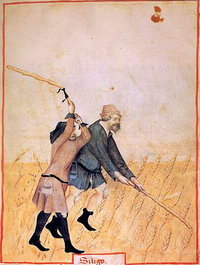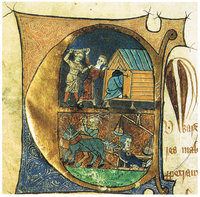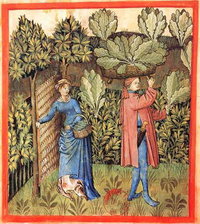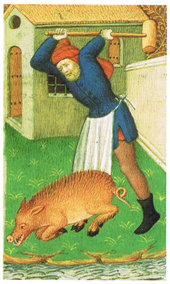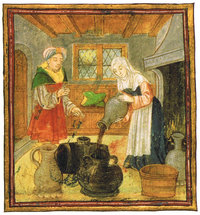Medieval cuisine
Medieval cuisine refers to the foods, eating habits, and cooking methods of various European cultures during the Middle Ages, a period roughly dating from the 5th to the 16th century. During this period, diets and cooking changed across Europe, and these changes helped lay the foundations for modern European cuisine.
Bread was the staple, followed by other foods made from cereals, such as porridge and pasta. Meat was more prestigious and more expensive than grain or vegetables. Common seasonings included verjuice, wine and vinegar. These, along with the widespread use of honey or sugar (among those who could afford it), gave many dishes a sweet-sour flavor. The most popular types of meat were pork and chicken, while beef, which required greater investment in land, was less common. Cod and herring were mainstays among the northern population, but a wide variety of other saltwater and freshwater fish were also eaten. Almonds, both sweet and bitter, were eaten whole as garnish, or more commonly ground up and used as a thickener in soups, stews, and sauces. Particularly popular was almond milk, which was a common substitute for animal milk during Lent and fasts.
Slow transportation and inefficient food preservation techniques prevented long-distance trade of many foods. For the most part, only the wealthy, especially the nobility, could afford imported ingredients such as spices, so their cuisine was more prone to foreign influence than the cuisine of poorer people. As each level of society imitated the one above it, innovations from international trade and foreign wars gradually disseminated through the upper middle class of medieval cities.
In a time when famine was commonplace and social hierarchies were often brutally enforced, food was an important marker of social status in a way that has no equivalent today in most developed countries. Aside from economic unavailability of luxuries such as spices, decrees outlawed consumption of certain foods among certain social classes, and sumptuary laws limited the conspicuous consumption among the nouveau riche who were not nobility. Social norms also dictated that the food of the working class be less refined, since it was believed there was a divine or natural resemblance between one's labor and one's food, so manual labor required coarser, cheaper food.
Dietary norms
The cuisines of the cultures around the Mediterranean had since antiquity been based on cereals, particularly various types of wheat. Porridge and gruel, and later bread became the basic food that made up the majority of calorie intake for most of the population. The dependence on wheat remained as significant long into medieval era, and with the rise of Christianity spread northwards. The centrality of bread in religious rituals such as the Eucharist meant that it enjoyed an especially high prestige among foodstuffs. Only (olive) oil and wine had a comparable value, but remained so much more exclusive outside of the warmer wine and olive growing regions. The role of bread as symbolic of sustenance (and even substance) is illustrated in a sermon given by Saint Augustine:
From the 8th to the 11th centuries, the proportion of various cereals rose from a mere 1/3 to around ¾ and bread remained the basic staple in most of Europe long into the modern era.

The Roman Catholic and Eastern Orthodox Churches and their calendars had great influence on eating habits; consumption of meat was forbidden for a full third of the year for most Christians, and all animal products, including eggs and dairy products (but not fish), were generally prohibited during Lent and fast. The church often made exceptions where non-animal alternatives were unavailable or simply unaffordable (e.g. the puffin being considered a fish for coastal fishermen in Norway). Exempt from fasting regulations were children, the old, pilgrims, workers and beggars, but not the poor as long as they had some sort of shelter. Additionally, it was customary for all citizens to fast prior to taking the Eucharist, and these fasts were occasionally for a full day and required total abstinence.
Medical science of the Middle Ages had a much greater influence on what was considered healthy and nutritious. One's lifestyle — including diet, exercise, appropriate social behavior, and approved medical remedies — was the way to good health, and all types of food were assigned certain properties that affected a person's health. All foodstuffs were also classified on scales ranging from hot to cold and moist to dry, according to the four bodily humors theory proposed by Galen that dominated Western medical science from late Antiquity until the 17th century.
Fasting
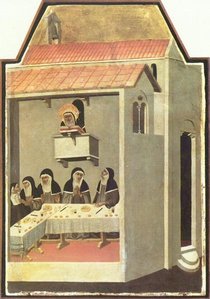
Apart from the regimen dictated by physicians, the medieval diet was heavily influenced by religious restrictions. Both the eastern and the western churches ordained that feast should be alternated with fast. In most of Europe, Wednesdays, Fridays, sometimes Saturdays and various other days on the calendar, including Lent and Advent, were fast days. Meat and animal products like milk, cheese, butter and eggs were not allowed, only fish. The fast was intended to mortify the body and invigorate the soul, to reinforce the medieval dogma that the flesh was inferior, and also to remind of Christ's sacrifice for humanity. The intention was not to portray certain foods as unclean, but rather that abstention was a spiritual lesson in self-restraint. During particularly severe fast days, the number of daily meals was also reduced to one. Even if most people respected these restrictions and usually made penance when they violated them, there were also numerous ways of circumventing the problem, a conflict of ideals and practice eloquently summarized by scholar Bridget Ann Henisch:
While animal products were to be avoided during times of penance, pragmatic compromises often prevailed. The definition of "fish" was often extended to marine and semi-aquatic animals such as whales, barnacle geese, puffins and even beavers. The choice of ingredients may have been limited, but that did not mean that meals were smaller. Neither were there any restrictions against (moderate) drinking or eating sweets. Banquets held on fish days could be splendid, and they were popular occasions for serving illusion food that imitated meat, cheese and eggs in various ingenious ways; fish could be molded to look like venison and fake eggs could made by stuffing empty egg shells with fish roe and almond milk and cooking it in coals. While Byzantine church officials took a hard-line approach, and discouraged any culinary refinement for the clergy, their western counterparts were far more lenient. There are many accounts of members of monastic orders who flouted fasting restrictions through clever interpretations of the Bible. Since the sick were exempt from fasting, there often evolved the notion that fasting restrictions only applied to the main dining area, and many friars would simply eat their fast day meals in what would later evolve into the misericord rather than the refectory. Newly assigned Catholic monastery officials sought to amend the problem of fast evasion not merely with moral condemnation, but by making sure that well-prepared non-meat dishes were available on fast days. There was also no lack of grumbling about the rigors of fast among the laity. During Lent, kings and schoolboys, commoners and nobility, all complained about being deprived of meat for the long, hard weeks of solemn contemplation of their sins. At Lent, owners of livestock were even warned to keep an eye out for hungry dogs frustrated by a "hard siege by Lent and fish bones".
Medieval dietetics
Template:Main Medieval scholars considered human digestion to be a process similar to cooking. The processing of food in the stomach was seen as a continuation of the preparation initiated by the cook. In order for the food to be properly "cooked" and for the nutrients to be properly absorbed, it was important that the stomach be filled in an appropriate manner. Easily digestible foods would be consumed first, followed by gradually heavier dishes. If this regimen was not respected it was believed that heavy foods would sink to the bottom of the stomach, thus blocking the digestion duct, so that food would digest very slowly and cause putrefaction of the body and draw bad humors into the stomach. It was also of vital importance that food of differing properties not be mixed.
Before a meal, the stomach would preferably be "opened" with an apéritif (from Latin aperire, "to open") that was preferably of a hot and dry nature: confections made from sugar- or honey-coated spices like ginger, caraway and seeds of anise, fennel or cumin, wine and sweetened fortified milk drinks. As the stomach had been opened, it should then be "closed" at the end of the meal with the help of a digestive, most commonly a dragée, which during the Middle Ages consisted of lumps of spiced sugar, or hypocras, a wine flavored with fragrant spices, along with aged cheese.
A meal would ideally begin with easily digestible fruit, such as apples. It would then be followed by vegetables such as lettuce, cabbage, purslane, herbs, moist fruits, light meats like chicken or goat kid with potages and broths. Later would be consumed heavy meats such as pork and beef, as well as vegetables and nuts like pears and chestnuts, both considered difficult to digest. It was popular (and recommended by medical expertise) to finish the meal with aged cheese and various digestives.
The most ideal food was that which most closely matched the humor of human beings, i.e. moderately warm and moist. Food should preferably also be finely chopped, ground, pounded and strained to achieve a true mixture of all the ingredients. White wine was believed to be cooler than red and the same distinction was applied to red and white vineagar. Milk was moderately warm and moist, but the milk of different animals was often believed to differ. Egg yolks were considered to be warm and moist while the whites were cold and moist. Skilled cooks were expected to conform to the regimen of humoral medicine. Even if this meant limitations in the combinations there was still plenty of room for artistic variation.
Regional variation
- Main article regional cuisines of medieval Europe.
Geographical variation was the result of differences in climate, political administration local customs that varied across the continent. Though sweeping generalizations should be avoided, more or less distinct areas where certain foodstuffs dominated can be discerned. In the British Isles, northern France, the Low Countries, the northern German-speaking areas, Scandinavia and the Baltic the climate was generally too harsh for the cultivation of grapes and olives. In the south, wine was the common drink for both rich and poor alike (though the commoner usually had to settle for cheap second pressing wine) while beer was the commoner's drink in the north and wine an expensive import. Citrus fruits (though not the kinds most common today) and pomegranates were common around in the Mediterranean. Dried figs and dates occurred in the north, but were used rather sparingly in cooking.
Olive oil was a ubiquitous ingredient around the Mediterranean, but remained an expensive import in the north where oil of poppy, walnut, hazel and filbert was the most affordable alternative. Butter and lard, especially after the terrible blood-letting of the population during the Black Death, was used in considerable quantities in the northern and northwestern regions, especially in the Low Countries. Almost universal in middle and upper class cooking all over Europe was the almond, which was in the ubiquitous and highly versatile almond milk, which was used as a substitute in dishes that otherwise required eggs or milk, though the bitter variety came along much later.
Meals
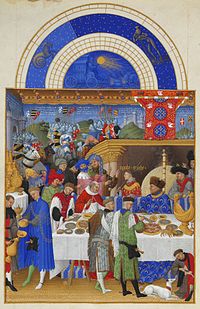
There were typically two meals a day: dinner at mid-day and a lighter supper in the evening. Moralists frowned on breaking the overnight fast too early, and members of the church and cultivated gentry avoided it. For practical reasons, breakfast was still eaten by most working men, and was tolerated for young children, women, the elderly and the sick. Because the church preached against gluttony and other weaknesses of the flesh, men tended to be ashamed of the weak practicality of breakfast. Lavish dinner banquets and late-night reresopers (from Occitan rèire-sopar, "late supper") with considerable amounts of alcoholic beverage were considered immoral. The latter were especially associated with the vices of gambling, crude language, drunkenness, and lewd behavior. Minor meals and snacks were common (although also disliked by the church), and working men commonly received an allowance from their employers in order to buy nuncheons, small morsels to be eaten during breaks.
Etiquette
There was an increasing trend throughout the Middle Ages to escape the stern collectivism that permeated the entire period. Otherwise the medieval meal was a communal affair, like every other part of life. The entire household, including servants, would ideally dine together. To sneak off to enjoy private company was considered a haughty and inefficient egotism in a world where people depended very much on each other. In the 13th century, English bishop Robert Grosseteste advised the Countess of Lincoln: "forbid dinners and suppers out of hall, in secret and in private rooms, for from this arises waste and no honour to the lord and lady." He also recommended to watch that the servants not make off with leftovers to make merry at rere-suppers, rather than giving it as alms. Although there are descriptions of dining etiquette on special occasions, less is known about the details of day to day meals of the elite or about the table manners of the common people and the destitute. However, it can be assumed there were no such extravagant luxuries as multiple courses, luxurious spices or hand-washing in scented water.
Things were different for the wealthy. Before the meal and between courses, shallow basins and linen towels were offered to guests so they could wash their hands, as cleanliness was emphasized. Social codes made it difficult for women to uphold the stereotype of being neat, delicate and immaculate while enjoying a sumptuous feast, so the wife of the host often dined in private with her entourage. She could then join dinner only after the potentially messy business of eating was done. Overall, fine dining was a predominantly male affair, and it was uncommon for anyone but the most honored of guests to bring his wife or her ladies-in-waiting. The hierarchical nature of society was reinforced by etiquette where the lower ranked were expected to help the higher, the younger to assist the elder, and men to spare women the risk of sullying dress and reputation by having to handle food in an unwomanly fashion. Shared drinking cups were common even at lavish banquets for all but those who sat at the high table, as was the standard etiquette of breaking bread and carving meat for one's fellow diners.
Food was mostly served on plates or in stew pots, and diners would take their share from the dishes and place it on trenchers of stale bread, wood or pewter with the help of spoons or bare hands. In lower-class households it was common to eat food straight off the table. Knives were used at the table, but most people were expected to bring their own, and only highly favored guests would be given a personal knife. A knife was usually shared with at least one other dinner guest, unless one was of very high rank or well-acquainted with the host. Forks for eating were not in widespread usage in Europe until the early modern period, and early on were limited to Italy. Even there it was not until the 14th century that the fork became common among Italians of all social classes. The change in attitudes can be illustrated by the reactions to the table manners of the Byzantine princess Theodora Doukaina in the late 11th century. She was the future wife of the Doge of Venice, Domenico Selvo, and caused considerable dismay among upstanding Venetians. The foreign consort's insistence on having her food cut up by her eunuch servants and then eating the pieces with a golden fork shocked and upset the diners so much that the Bishop of Ostia later interpreted her refined foreign manners as pride and referred to her as "...the Venetian Doge's wife, whose body, after her excessive delicacy, entirely rotted away."
Food preparation
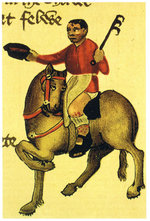
All types of cooking involved the direct use of fire. Stoves did not appear until the 18th century, and cooks had to know how to cook directly over an open fire. Ovens were used, but they were expensive to construct and only existed in fairly large households and bakeries. It was common for a community to have shared ownership of an oven to ensure that the bread baking essential to everyone was made communal rather than private. There were also portable ovens designed to be filled with food and then buried in hot coals, and even larger ones on wheels that were used to sell pies in the streets of medieval towns. But for most people, almost all cooking was done in simple stewpots, since this was the most efficient use of firewood and did not waste precious cooking juices, making potages and stews the most common dishes. Overall, most evidence suggests that medieval dishes had a fairly high fat content, or at least when fat could be afforded. This was considered less of a problem in a time of back-breaking toil, famine, and a greater acceptance - even desirability - of plumpness; only the poor or sick, and devout ascetics, were thin.
Fruit was readily combined with meat, fish and eggs. The recipe for Tart de brymlent, a fish pie from the recipe collection Forme of Cury, includes a mix of figs, raisins, apples and pears with fish (salmon, codling or haddock) and pitted damson plums under the top crust. It was more important to make sure that the dish agreed with contemporary standards of medicine and dietetics. This meant that food had to be "tempered" according to its nature by an appropriate combination of preparation and mixing certain ingredients, condiments and spices. For example, fish was considered to be quite cold and moist, and best cooked in a way that heated and dried it, such as frying or oven baking, and seasoned with hot and dry spices; beef was dry and hot and should therefore be boiled; pork was hot and moist and should therefore always be roasted. In some recipe collections, alternative ingredients were assigned with more consideration to the humoral nature than similarity in taste. In a recipe for quince pie, cabbage is given as working equally well, and in another turnips are considered to be the equivalent of pears.
The completely edible shortcrust pie did not appear in recipes until the 15th century. Before that the bread was primarily used as a cooking container. Extant recipe collections show that gastronomy in the Late Middle Ages developed significantly. New techniques, like the shortcrust pie and the clarification of jelly with egg whites began to appear in recipes in the late 14th century and recipes began to include detailed instructions instead of being mere memory aides.
The medieval kitchen
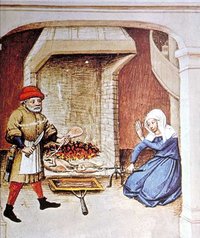
In most households, cooking was done on an open hearth in the middle of the main living area, to make efficient use of the heat. This was the most common arrangement, even in wealthy households, for most of the Middle Ages, where the kitchen was combined with the dining hall. Towards the Late Middle Ages a separate kitchen area began to evolve. The first step was to move the fireplaces towards the walls of the main hall, and later to build a separate building or wing that contained a dedicated kitchen area, often separated from the main building by a covered arcade. This way, the smoke, odors and bustle of the kitchen could be kept out of sight of guests, and the fire risk lessened.
Many basic variations of cooking utensils available today, such as frying pans, pots, kettles, and waffle irons, already existed, even if they were often too expensive for poorer households. Other tools more specific to cooking over an open fire were spits of various sizes, and material for skewering anything from delicate quails to whole oxen. There were also cranes with adjustable hooks so that pots and cauldrons could easily be swung away from the fire to keep them from burning or boiling over. Utensils were often held directly over the fire or placed into embers on tripods. To assist the cook there were also assorted knives, stirring spoons, ladles and graters. In wealthy households one of the most common tools was the mortar and sieve cloth, since many medieval recipes called for food to be finely chopped, mashed, strained and seasoned either before or after cooking. This was based on a belief among physicians that the finer the consistency of food, the more effectively the body would absorb the nourishment. It also gave skilled cooks the opportunity to elaborately shape the results. Fine-textured food was also associated with wealth, for example finely-milled flour was more expensive, while the bread of commoners was typically brown and coarse. A typical procedure was to skin and dress an animal, grind up the meat and mix it with spices and other ingredients and return it into its own skin, or mold it into the shape of a completely different animal.
The kitchen staff of huge noble or royal courts occasionally numbered in the hundreds: pantlers, bakers, waferers, sauciers, larderers, butchers, carvers, page boys, milk maids, butlers and countless scullions. While an average peasant household often made do with firewood collected from the surrounding woodlands, the major kitchens of households had to cope with the logistics of daily providing at least two meals for several hundred people. Guidelines on how to prepare for a two-day banquet can be found in the 15th-century cookbook Du fait de cuisine ("On cookery") by Chiquart, master chef of Amadeus VIII, Duke of Savoy. Chiquart recommends that the chief cook should have at hand at least 1,000 cartloads of "good, dry firewood" and a large barnful of coal.
Preservation
Food preservation methods were basically the same as had been used since antiquity, and did not change much until the invention of canning in the early 19th century. The most common and simplest method was to expose foodstuffs to heat or wind to remove moisture, thereby prolonging the durability if not the flavor of almost any type of food from cereals to meats; the drying of food worked by drastically reducing the activity of various water-dependent microorganisms that cause decay. In warm climates this was mostly achieved by leaving food out in the sun, and in the cooler northern climates by exposure to strong winds (especially common for the preparation of stockfish), or in warm ovens, cellars, attics, and at times even in living quarters.
Subjecting food to a number of chemical processes such as smoking, salting, brining, conserving or fermenting also made it keep longer. Most of these methods had the advantage of shorter preparation times and of introducing new flavors. Smoking or salting meat of livestock butchered in the fall was a common household strategy to avoid having to feed more animals than necessary during the lean winter months. Butter tended to be heavily salted (5–10%) in order not to spoil. Vegetables, eggs or fish were also often pickled in tightly packed jars, containing brine and acidic liquids (lemon juice, verjuice or vinegar). Another method was to create a seal around the food by cooking it in sugar or honey or fat, in which it was then stored. Bacterial modification was also encouraged, however, by a number of methods; grains, fruit and grapes were turned into alcoholic drinks that disinfected the beverage, and milk was fermented and cured into a multitude of cheeses or buttermilk.
Cereals
The phrase Our daily bread was a concrete reality during the Middle Ages. Food intake among all social classes consisted mainly of cereals, usually in the form of bread and, to a lesser extent, gruel, porridge, and pasta. Estimates of bread consumption all over Europe are fairly similar: around 1–1.5 kg (2–3 lb) of bread per person per day. The most common grains were rye, barley, buckwheat, millet, and oats. Rice remained a fairly expensive import for most of the Middle Ages and was grown in northern Italy only towards the end of the period. Wheat was common all over Europe and was considered to be the most nutritious of all grains, but was more prestigious and thus more expensive. The finely sifted white flour that modern Europeans are most familiar with was reserved for the bread of the upper classes, while those of lower status ate bread that became coarser, darker and of a higher bran content the lower one was on the social ladder. In times of grain shortages or outright famine, grains could be supplemented with cheaper and less desirable substitutes like chestnuts, dried legumes, acorns, ferns, and a wide variety of more or less nutritious vegetable matter.
One of the most common constituents of a medieval meal, either as part of a banquet or as a small snack, were sops, pieces of bread with which a liquid like wine, soup, broth, or sauce could be soaked up and eaten. Another common sight at the medieval dinner table was the frumenty, a thick wheat porridge often boiled in a meat broth and seasoned with spices. Porridges were also made of every type of grain and could be served as desserts or dishes for the sick, if boiled in milk (or almond milk) and sweetened with sugar. Pies filled with meats, eggs, vegetables, or fruit were common throughout Europe, as were turnovers, fritters, doughnuts, and many similar pastries. By the Late Middle Ages biscuits (cookies in the U.S.) and especially wafers, eaten for dessert, had become high-prestige foods and came in many varieties. Grain, either as bread crumbs or flour, was also the most common thickener of soups and stews, alone or in combination with almond milk.
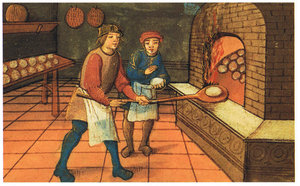
The importance of bread as a daily staple meant that bakers played a crucial role in any medieval community. Among the first town guilds to be organized were the bakers', and laws and regulations were passed to keep bread prices stable. The English Assize of Bread and Ale of 1266 listed extensive tables where the size, weight, and price of a loaf of bread was regulated in relation to grain prices. The baker's profit margin stipulated in the tables was later increased through successful lobbying from the London Baker's Company by adding the cost of everything from firewood and salt to the baker's wife, house, and dog. Since bread was such a central part of the medieval diet, swindling by those who were trusted with supplying the precious commodity to the community was considered a serious offense. Bakers who were caught tampering with weights or adulterating dough with less expensive ingredients could receive severe penalties. This gave rise to the "baker's dozen": a baker would give 13 for the price of 12, to be certain of not being known as a cheat.
Bread was used for more than just eating: though often of wood or metal (mostly pewter), trenchers that served as dinner plates in affluent households were made out of old bread made from unsifted flour far into the early modern era, and bread was used to wipe off knives when passing them to the next diner or before fishing out salt from the shared salt cellars. Even the seemingly carefree handling of hot metal serving plates could be achieved with slices of bread neatly tucked into the hands of servants, but still away from the unforgiving gaze of fussy, high-ranking diners.
Fruit and vegetables
While grains were the primary constituent of most meals, vegetables such as cabbage, beets, onions, garlic and carrots were common foodstuffs. Many of these were eaten daily by peasants and workers, but were less prestigious than meat. The cookbooks, intended mostly for those who could afford such luxuries, which appeared in the late Middle Ages, only contained a small number of recipes using vegetables other than side dishes and the occasional potage. Carrots were available in many variants during the Middle Ages: among them a tastier reddish-purple variety and a less prestigious green-yellow type. Various legumes, like chickpeas, fava beans and peas were also common and important sources of protein. With the exception of peas, they were frowned on by contemporary dietetics, partly because of their tendency to cause flatulence. The importance of vegetables to the common people is illustrated by accounts from 16th-century Germany stating that many peasants ate sauerkraut three to four times a day.
Fruit was popular and could be served fresh, dried, or preserved, and was a common ingredient in many meat dishes. Since sugar and honey were expensive, it was common to include many types of fruit in dishes that called for sweeteners of some sort. The fruits of choice in the south were lemons, citrons, bitter oranges (the sweet type was not introduced until several hundred years later), pomegranates, quinces, and, of course, grapes. Further north, apples, pears, plums, and strawberries were more common. Figs and dates were eaten all over Europe, but remained rather expensive imports in the north.
Common and often basic ingredients in many modern European cuisines like potatoes, kidney beans, cacao, vanilla, tomatoes, chili peppers and maize were not available to Europeans until the late 15th century with the European contact with the Americas, and even then it often took a long time for the new foodstuffs to be accepted by society at large.
Meats
While all forms of wild game were popular among those who could obtain it, most meat came from domesticated animals. Beef was not as common as today because raising cattle was labor-intensive, requiring pastures and feed, and oxen and cows were much more valuable as draught animals and for producing milk. Animals slaughtered because they were no longer able to work were not particularly appetizing and were therefore less valued. Far more common was pork, as pigs required less attention and cheaper feed. Domestic pigs often ran freely even in towns and could be fed on just about any organic kitchen waste, and suckling pig was a sought-after delicacy. Mutton and lamb were fairly common, especially in areas with a sizeable wool industry, as was veal. Unlike most of the modern Western world, just about every part of the animal was eaten, including ears, snout, tail, tongue, and womb. Intestines, bladder and stomach could be used as casings for sausage or even illusion food such as giant eggs. Among the meats that today are rare or even considered inappropriate for human consumption were hedgehog and porcupine, occasionally mentioned in late medieval recipe collections. Both were considered lesser forms of pig, hence their names.
A wide range of birds was eaten, including swans, peafowl, quail, partridge, storks, cranes, larks and just about any wild bird that could be hunted. Swans and peafowl were often domesticated, but were only eaten by the social elite, and more praised for their fine appearance (often used to create stunning entremets) than for their meat. As today, geese and ducks had been domesticated but were not as popular as the chicken, the fowl equivalent of the pig. Curiously enough the barnacle goose was believed to reproduce not by laying eggs like other birds, but by growing in barnacles, and was hence considered acceptable food for fast and Lent.
Meats were more expensive than plant foods. Though rich in protein, the calorie-to-weight ratio of meat was less than that of plant food. Meat could be up to four times as expensive as bread. Fish was up to 16 times as costly, and was still expensive even for coastal populations. This meant that fasts could mean an especially meager diet for those who could not afford alternatives to meat and animal products like milk and eggs. It was only after the Black Death had eradicated up to half of the European population that meat became more common even for poorer people. The drastic reduction in many populated areas resulted in a labor shortage, meaning that wages shot up. It also left vast areas of farmland untended, making them available for pasture and putting more meat on the market.
Fish and seafood
Although less prestigious than other animal meats, and often seen as merely an alternative to meat on fast days, seafood was still the mainstay of many coastal populations. "Fish" to the medieval man was also a general name for anything not considered a proper land-living animal, including marine mammals such as whales and porpoises. Also included were the beaver, due to its scaly tail and considerable time spent in water, and barnacle geese, due to lack of knowledge of where they migrated. Such foods were also considered appropriate for fast days. Especially important was the fishing and trade in herring and cod in the Atlantic and the Baltic Sea. The herring was of unprecedented significance to the economy of much of Northern Europe, and it was one of the most common commodities traded by the Hanseatic League, a powerful north German alliance of trading guilds. Kippers made from herring caught in the North Sea could be found in markets as far away as Constantinople. While large quantities of fish were eaten fresh, a large proportion was salted, dried, and, to a lesser extent, smoked. Stockfish, cod that was split down the middle, fixed to a pole and dried, was very common, though preparation could be time-consuming, and meant beating the dried fish with a mallet before soaking it in water. A wide range of mollusks including oysters, mussels and scallops were eaten by coastal and river-dwelling populations, and freshwater crayfish were seen as a desirable alternative to meat during fish days. Compared to meat, fish was much more expensive for inland populations, especially in Central Europe, and therefore not an option for most. Freshwater fish such as pike, carp, bream, perch, lamprey, and trout were common.
Drink

In modern times, water is seen as a common choice to drink with a meal. In the Middle Ages, however, concerns over purity, medical recommendations and its low prestige value made it less favored, and alcoholic beverages were always preferred. They were seen as more nutritious and beneficial to digestion than water, with the invaluable bonus of being less prone to putrefaction due to the alcohol content. Wine was consumed on a daily basis in most of France and all over the Western Mediterranean wherever grapes were cultivated. Further north it remained the preferred drink of the bourgeoisie and the nobility who could afford it, and far less common among peasants and workers. The drink of commoners in the northern parts of the continent was primarily beer or ale. Because of the difficulty of preserving this beverage for any time (especially before the introduction of hops), it was mostly consumed fresh; it was therefore cloudier and perhaps had a lower alcohol content than the typical modern equivalent. Plain milk was not consumed by adults except the poor or sick, being reserved for the very young or elderly, and then usually as buttermilk or whey. Fresh milk was overall less common than other dairy products because of the lack of technology to keep it from spoiling.
Juices, as well as wines, of a multitude of fruits and berries had been known at least since Roman antiquity and were still consumed in the Middle Ages: pomegranate, mulberry and blackberry wines, perry, and cider which was especially popular in the north where both apples and pears were plentiful. Medieval drinks that have survived to this day include prunellé from wild plums (modern-day slivovitz), mulberry gin and blackberry wine. Many variants of mead have been found in medieval recipes, with or without alcoholic content. However, the honey-based drink became less common as a table beverage towards the end of the period and eventually wound up primarily as a sick-potion. Kumis, the fermented milk of mares or camels, was known in Europe, but as with mead was mostly something prescribed by physicians. Mead has often been presented as the common drink of the Slavs. This is partially true since mead bore great symbolic value at important occasions. When agreeing on treaties and other important affairs of state, mead was often presented as a ceremonial gift. It was also common at weddings and baptismal parties, though in limited quantity due to its high price. In medieval Poland, mead had a status equivalent to that of imported luxuries, such as spices and wines.
Wine
Wine was commonly drunk and was also regarded as the most prestigious and healthy choice. According to Galen's dietetics it was considered hot and dry (hence the modern use of "dry" in describing wine), but these qualities were moderated when wine was watered down. Unlike water or beer, which were considered cold and moist, consumption of wine in moderation (especially red wine) was, among other things, believed to aid digestion, generate good blood and brighten the mood. The quality of wine differed considerably according to vintage, the type of grape and more importantly, the number of grape pressings. The first pressing was made into the finest and most expensive wines which were reserved for the upper classes. The second and third pressings were subsequently of lower quality and alcohol content. Common folk usually had to settle for a cheap white or rosé from a second or even third pressing, meaning that it could be consumed in quite generous amounts without leading to heavy intoxication. For the poorest (or the most pious), watered-down vinegar would often be the only available choice.
The aging of high quality red wine required specialized knowledge as well as expensive storage and equipment, and resulted in an even more expensive end product. Judging from the advice given in many medieval documents on how to salvage wine that bore signs of going bad, preservation must have been a widespread problem. Even if vinegar was a common ingredient, there was only so much of it that could be used. In the 14th-century cookbook Le Viandier there are several methods for salvaging spoiling wine; making sure that the wine barrels are always topped up or adding a mixture of dried and boiled white grape seeds with the ash of dried and burnt lees of white wine were both effective bactericides, even if the chemical processes were not understood at the time. Spiced or mulled wine was not only popular among the affluent, but was also considered especially healthy by physicians. Wine was believed to act as a kind of vaporizer and conduit of other foodstuffs to every part of the body, and the addition of fragrant and exotic spices would make it even more wholesome. Spiced wines were usually made by mixing an ordinary (red) wine with an assortment of spices such as ginger, cardamom, pepper, grains of paradise, nutmeg, cloves and sugar. These would be contained in small bags which were either steeped in wine or had liquid poured over them to produce hypocras and claré. By the 14th century, bagged spice mixes could be bought ready-made from spice merchants.
Beer
Template:Main While wine was the most common table beverage in much of Europe, this was not the case in the northern regions where grapes were not cultivated. Those who could afford it drank imported wine, but even for nobility in these areas it was common to drink beer or ale, particularly towards the end of the Middle Ages. In England, the Low Countries, northern Germany, Poland and Scandinavia, beer was consumed on a daily basis by people of all social classes and age groups. However, the heavy influence from Arab and Mediterranean culture on medical science (particularly due to the Reconquista and the influx of Arabic texts) meant that beer was often heavily disfavored. For most medieval Europeans, it was a humble brew compared with common southern drinks and cooking ingredients, such as wine, lemons and olive oil. Even comparatively exotic products like camel's milk and gazelle meat generally received more positive attention in medical texts. Beer was just an acceptable alternative and was assigned various negative qualities. In 1256, the Sienese physician Aldobrandino described beer in the following way:
The intoxicating effect of beer was believed to last longer than that of wine, but it was also admitted that it did not create the "false thirst" associated with wine. Though less prominent than in the north, beer was consumed in northern France and the Italian mainland. Perhaps as a consequence of the Norman conquest and the travelling of nobles between France and England, one French variant described in the 14th-century cookbook Le Menagier de Paris was called godale (most likely a direct borrowing from the English "good ale") and was made from barley and spelt, but without hops. In England there were also the variants poset ale, made from hot milk and cold ale, and brakot or braggot, a spiced ale prepared much like hypocras.
That hops could be used for flavoring beer had been known at least since Carolingian times, but was adopted gradually due to difficulties in establishing the appropriate proportions. Before the discovery of hops, gruit, a mix of various herbs, had been used. Gruit did not have the same preserving properties as hops, and the end result had to be consumed quickly to avoid the inevitable spoiling. Another flavoring method was to increase the alcohol content, but this was more expensive and lent the beer the undesired characteristic of being a quick and heavy intoxicant. In the Early Middle Ages beer was primarily brewed in monasteries, and on a smaller scale in individual households. By the High Middle Ages breweries in the fledgling medieval towns of northern Germany began to take over production. Though most of the breweries were small family businesses that employed at most eight to ten people, regular production allowed for investment in better equipment and increased experimentation with new recipes and brewing techniques. These operations later spread to Holland in the 14th century, then to Flanders and Brabant, and reached England by the 15th century. Hopped beer became very popular in the last decades of the Late Middle Ages. In England and the Low Countries, the per capita annual consumption was around 275–300 liters (60–66 gallons), and it was consumed with practically every meal: low alcohol-content beers for breakfast, and stronger ones later in the day. When perfected as an ingredient, hops could make beer keep for six months or more, and facilitated extensive exports.
Distillates
The ancient Greeks and Romans also knew of the technique, but it was not practiced on a major scale until some time around the 12th century, when Arabic innovations in the field combined with water-cooled glass alembics were introduced. Distillation was believed by medieval scholars to produce the essence of the liquid being purified, and the term aqua vitae ("water of life") was used as a generic term for all kinds of distillates into the 17th century. The early use of various distillates, alcoholic or not, was varied, but it was primarily culinary or medicinal; grape syrup mixed with sugar and spices was prescribed for a variety of ailments, and rose water was used as a perfume and cooking ingredient and for hand washing. Alcoholic distillates were also occasionally used to create dazzling, fire-breathing entremets (a type of entertainment dish served between courses) by soaking a piece of cotton in spirits. It would then be placed in the mouth of the stuffed, cooked and occasionally redressed animals, and lit just before presenting the creation.
Aqua vitae in its alcoholic forms was highly praised by medieval physicians. In 1309 Arnaldus of Villanova wrote that "It prolongs good health, dissipates superfluous humours, reanimates the heart and maintains youth." In the Late Middle Ages, the production of moonshine started to pick up, especially in the German-speaking regions. By the 13th century, Hausbrand (literally "home-burnt" from gebrannter wein, brandwein; "burnt (distilled) wine") was commonplace, marking the origin of brandy. Towards the end of the Late Middle Ages, the consumption of spirits became so engrained even among the general population that restrictions on sales and production began to appear in the late 15th century. In 1496 the city of Nuremberg issued restrictions on the selling of aquavit on Sundays and official holidays.
Herbs and spices
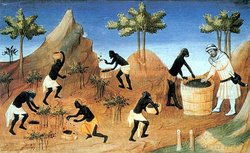
Spices were among the most luxurious products available in the Middle Ages, the most common being black pepper, cinnamon (and the cheaper alternative cassia), cumin, nutmeg, ginger and cloves. They all had to be imported from plantations in Asia and Africa, which made them extremely expensive. It has been estimated that around 1,000 tons of pepper and 1,000 tons of the other common spices were imported into Western Europe each year during the late Middle Ages. The value of these goods was the equivalent of a yearly supply of grain for 1.5 million people. While pepper was the most common spice, the most exclusive was saffron, used as much for its vivid yellow-red color as for its flavor. Spices that have now fallen into some obscurity include grains of paradise, a relative of cardamom which almost entirely replaced pepper in late medieval north French cooking, long pepper, mace, spikenard, galangal and cubeb. Sugar, unlike today, was considered to be a type of spice due to its high cost and humoral qualities.
Common herbs such as sage, mustard, and especially parsley were grown and used in cooking all over Europe, as were caraway, mint, dill and fennel. Anise could be used to flavor fish and chicken dishes, and its seeds were served as sugar-coated comfits. Locally grown herbs were more affordable and were also used in upper-class food, but were then usually less prominent or included merely as coloring. A popular modern-day misconception is that medieval cooks used liberal amounts of spices, particularly black pepper, merely to disguise the taste of spoiled meat. However, a medieval feast was as much a culinary event as it was a display of the host's vast resources and generosity, and as most nobles had a wide selection of fresh or preserved meats, fish or seafood to choose from, the use of ruinously expensive spices on cheap, rotting meat would have made little sense.
Sweets and desserts
The term "dessert" comes from the Old French desservir, "to clear a table", literally "to un-serve", and originated during the Middle Ages. It would typically consist of dragées and mulled wine accompanied by aged cheese, and by the Late Middle Ages could also include fresh fruit covered in sugar, honey or syrup and boiled-down fruit pastes. There was a wide variety of fritters, crêpes with sugar, sweet custards and darioles, almond milk and eggs in a pastry shell that could also include fruit and sometimes even bone marrow or fish.[1] German-speaking areas had a particular fondness for krapfen: fried pastries and dough with various sweet and savory fillings. Marzipan in many forms was well-known in Italy and southern France by the 1340s and is assumed to be of Arab origin.[2] Anglo-Norman cookbooks are full of recipes for sweet and savory custards, potages, sauces and tarts with strawberries, cherries, apples and plums. The English chefs also had a penchant for using flower petals of roses and elderberry. An early form of quiche can be found in Forme of Cury, a 14th-century recipe collection, as a Torte de Bry with a cheese and egg yolk filling.
In northern France, a wide assortment of waffles and wafers was eaten with cheese and hypocras or a sweet malmsey as issue de table ("departure from the table"). The ever-present candied ginger, coriander, aniseed and other spices were referred to as épices de chambre ("parlor spices") and were taken as digestables at the end of a meal to "close" the stomach. Like their Muslim counterparts in Spain, the Arab conquerors of Sicily introduced a wide variety of new sweets and desserts that eventually found their way to the rest of Europe. Just like Montpellier, Sicily was once famous for its comfits, nougat candy (torrone, or turrón in Spanish) and almond clusters (confetti). From the south, the Arabs also brought the art of ice cream making that produced sherbets and several examples of sweet cakes and pastries; cassata alla Siciliana (from Arabic qas'ah, the term for the terra cotta bowl with which it was shaped), made from marzipan, sponge cake and sweetened ricotta and cannoli alla Siciliana, originally cappelli di turchi ("Turkish hats"), fried, chilled pastry tubes with a sweet cheese filling.
See also
- Regional cuisines of medieval Europe
- Early modern European cuisine
- Guillaume Tirel
- Frumenty
- Sop
- Entremet
- Apicius
References
- Adamson, Melitta Weiss (2004) Food in Medieval Times ISBN 0-313-32147-7
- Dembinska, Maria (1999) Food and drink in medieval Poland: rediscovering a cuisine of the past, translated by Magdalena Thomas, revised and adapted by William Woys Weaver ISBN 0-8122-3224-0
- The Fontana Economic History of Europe: The Middle Ages (1972); J.C Russel Population in Europe 500–1500 ISBN 0-00-632841-5
- Food in the Middle Ages: A Book of Essays (1995) edited by Melitta Weiss Adamson ISBN 0-8153-1345-4
- Henisch, Bridget Ann (1976), Fast and Feast: Food in Medieval Society ISBN 0-271-01230-7
- Hunt, Edwin S. & Murray, James H. (1999) A history of business in Medieval Europe, 1200-1550 0-521-49923-2
- Medieval science, technology, and medicine : an encyclopedia (2005) Thomas Glick, Steven J. Livesey, Faith Wallis, editors ISBN 0-415-96930-1
- Regional Cuisines of Medieval Europe: A Book of Essays (2002) edited by Melitta Weiss Adamson ISBN 0-415-92994-6
- Scully, Terence (1995) The Art of Cookery in the Middle Ages ISBN 0-85115-611-8
External links
- Le Viandier de Taillevent - An online translation of the 14th-century cookbook by James Prescott
- Medieval cookery books at the British Library - Learning resources on the medieval kitchen
- How to Cook Medieval - A guide on how to make medieval cuisine with modern ingredients
- The Forme of Cury - A late 14th-century English cookbook, available from Project Gutenberg
- Cariadoc's Miscellany - A collection of articles and recipes on medieval and Renaissance food
- MedievalCookery.com - Recipes, information, and notes about cooking in medieval Europe
- Olde Hansa - The medieval restaurant of Tallinn - contains also information about cooking, eating habit and culture during the hanseatic times
- Feeding the poor in medieval Catalonia
- Nutrition and the Early-Medieval Diet
- Dietary Requirements of the Medieval Peasant
- Making Medieval Sauces
Template:Featured article
Template:CuisineHistory
Template:Middle Ages wide 2
